How to Make Marigolds Bushier: Easy Tips for Lush Blooms
If you’re a fan of vibrant gardens, you know how much a splash of yellow and orange can brighten up your day. Marigolds are fantastic for adding color and are relatively easy to maintain. To make your marigolds bushier, you need to encourage them to branch out. Pinching off the top growth of your marigold helps the plant to become fuller and more robust, giving your garden a lush look.
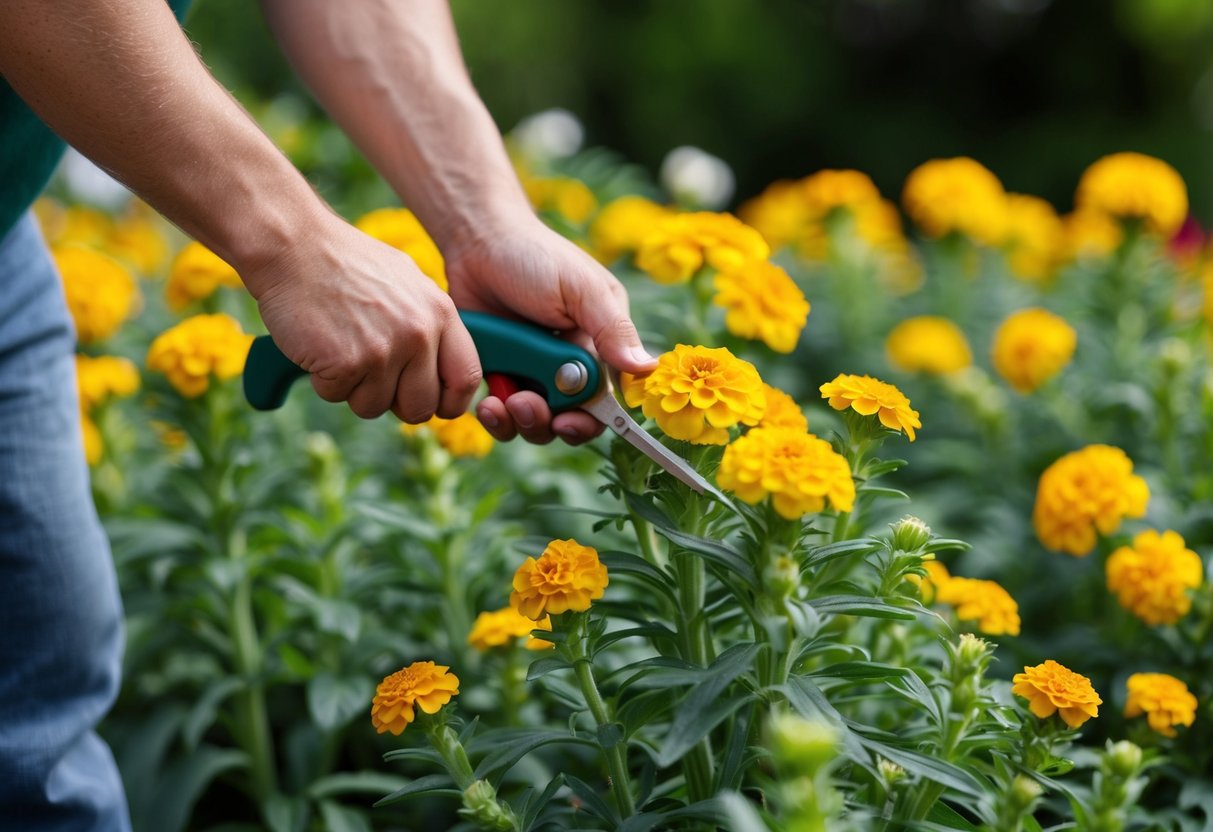
Gardening doesn’t have to be complicated, and marigolds are proof of that. By spending just a little time each week tending to the pinching and pruning, you can ensure your plants stay healthy and thriving. The technique is simple: use your thumb and forefinger to carefully nip off the top part of the stem.
A fuller marigold not only enhances your garden’s visual appeal but also benefits from better air circulation, which can lead to fewer pest and disease problems. If you’re ready to transform your gardening routine and get the most out of your marigolds, learning how to properly pinch and prune is the way to go.
Understanding Marigold Varieties
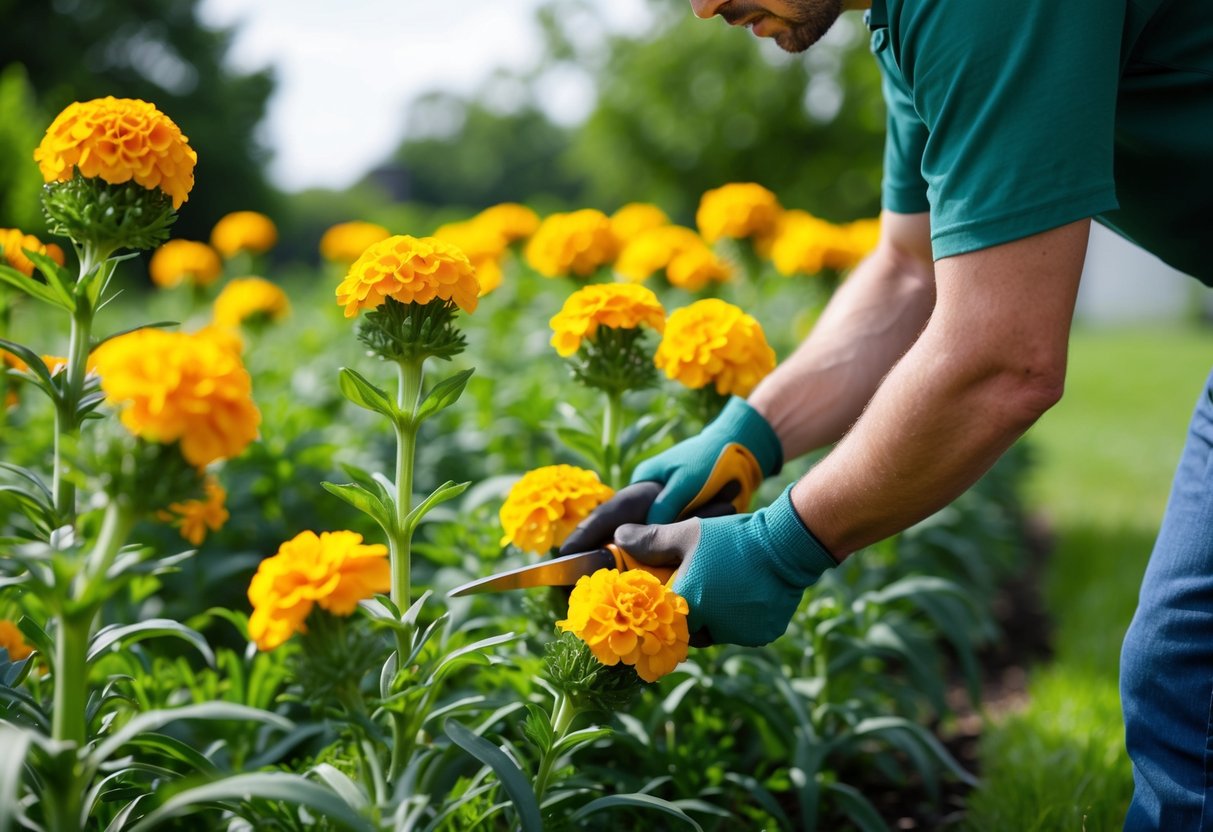
Choosing the right marigold variety impacts your garden’s look and growth. Marigolds come in different types like French, African, and Signet, each with unique characteristics.
Distinguishing Between French, African, and Signet Marigolds
French Marigolds are compact, making them great for borders or containers. They produce vibrant colors ranging from red to yellow. They’re well-suited for a wide range of climates and can thrive in hardiness zones 2 through 11.
African Marigolds, also called Tagetes erecta, are taller and are often used as background plants in gardens. They bring larger blooms and handle heat well. They prefer zones 2 through 11 too and can transform large spaces with their bold colors.
Signet Marigolds offer small, delicate flowers and a pleasant citrus scent. They’re perfect for containers and edging due to their petite size. Their ease of care makes them popular, especially in warmer climates, where they thrive best. Consider using signet marigolds for a subtle yet colorful touch to your garden.
Essentials of Marigold Care

Providing marigolds with the right care is key to their vibrant blooms and healthy growth. Focus on sunlight, water, soil, and fertilization to help your plants reach their full potential.
Sunlight and Water Requirements
Marigolds thrive in full sunlight, needing about 6-8 hours of direct sunlight each day. This helps them grow strong and produce plenty of blooms. If you live in a region with extremely hot weather, consider providing some afternoon shade to prevent wilting.
Watering should be done carefully. Aim to water at the soil level, avoiding the foliage to prevent disease. Generally, marigolds need a good soak once a week. Check the top inch of soil; if it feels dry, it’s time to water. These practices help maintain the optimal growth of your marigolds.
Optimizing Soil and Fertilization
Choose a well-draining soil for your marigolds. A high-quality commercial potting soil works well. Good drainage is crucial to avoid root rot. To enhance nutrient content, you can mix in compost or well-rotted manure.
For fertilization, use a balanced, slow-release fertilizer. Apply it once a month during the growing season. Avoid over-fertilizing, as this can lead to lush foliage but few flowers. Keep these guidelines in mind for effective plant care and you’ll enjoy bushy, vibrant marigolds in your garden.
Pruning Basics for Marigolds
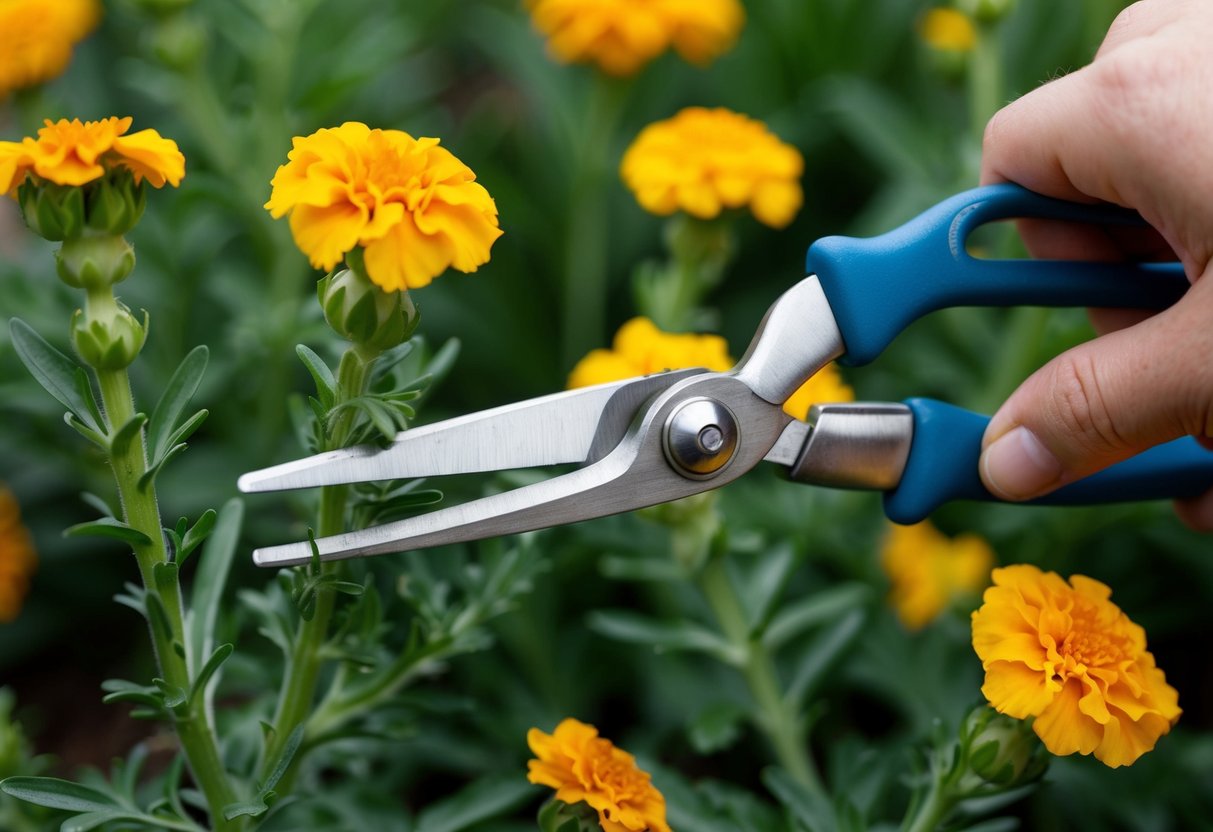
Pruning marigolds involves knowing the right time and techniques to encourage bushy growth and more blooms. With these tips, you can keep your marigolds healthy and flourishing.
When to Prune Marigolds
The best time to prune marigolds is during the growing season when they are actively blooming. Regular pruning helps control the shape and encourages bushier growth. You should remove any dead or dying blooms and leaves to help the plant focus its energy on producing new flowers.
Late afternoon or evening is an ideal time to prune since the weather is cooler and the plant will have time to recover overnight. This method also helps in extending the blooming period.
Correct Pruning Techniques
Start by using clean and sharp pruning shears or bypass pruners. Identify the spent blooms and cut them back to about 1-2 inches above the soil line. Trim any leggy or straggly stems for a tidier look and encourage side shoots.
When you spot dead or damaged leaves, use your shears to remove them carefully. Be sure to make clean cuts just above a set of healthy leaves. These practices will create a fuller, bushier marigold plant with more buds ready to bloom.
Encouraging Bushier Growth
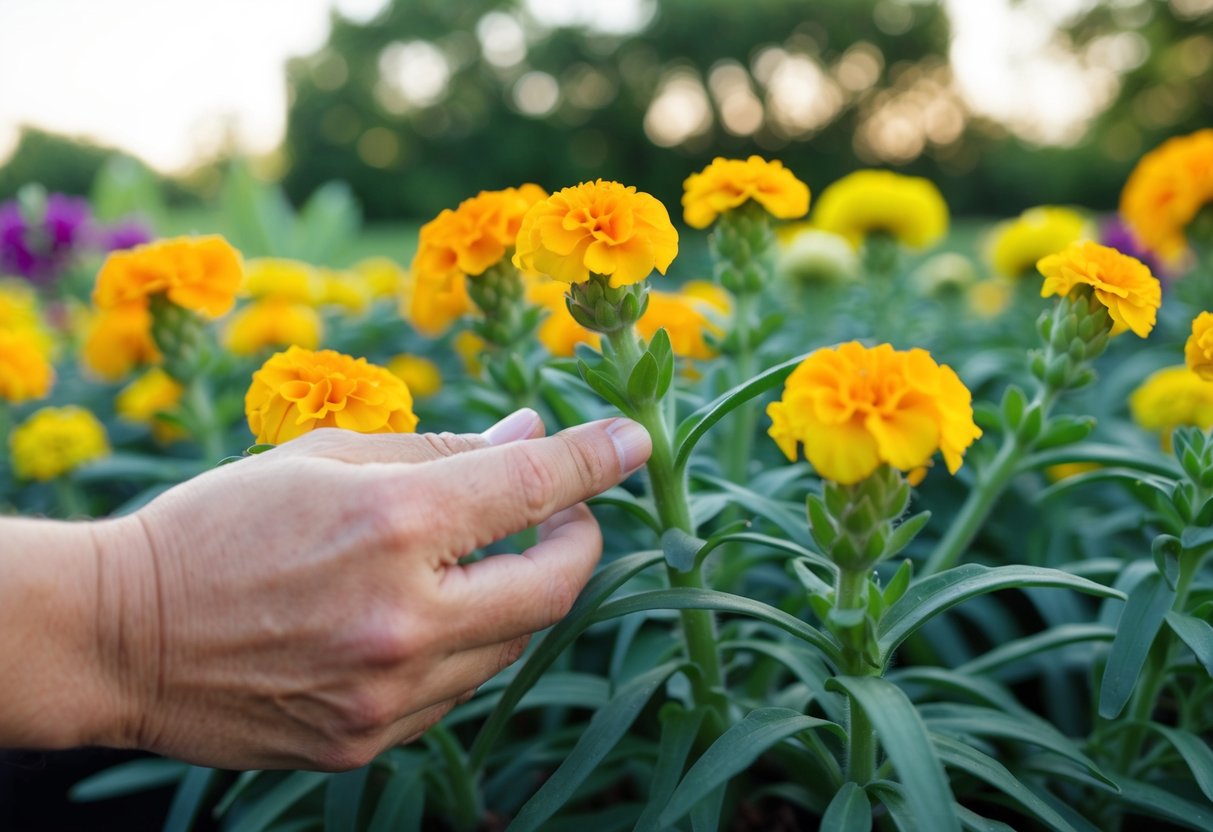
To make your marigolds bushier, focus on two main techniques: deadheading and pinching. Each method helps in a unique way by increasing the number of blooms and promoting fuller plant growth.
Deadheading for Continuous Blooms
Deadheading involves removing spent flowers from your marigold plant. By cutting back the old blooms, you encourage the plant to continue producing new ones. This not only keeps your garden looking fresh but also promotes bushy growth.
Simply snip the faded flowers right above the first set of leaves or where you see a new flower bud forming.
Regular deadheading is key for continuous blooming. Make it a habit to check your plants once a week. Removing the wilting flowers redirects the plant’s energy back into growth. This process helps create more flower buds, which leads to a healthier and fuller plant.
Pinching for Denser Foliage
Pinching is another effective way to encourage marigolds to grow bushier. This technique involves cutting back the tips of the stems. When you pinch marigolds, you stimulate the plant to develop more side shoots.
To pinch marigolds, use your thumb and forefinger to nip off the top of the stem right above a leaf node. This triggers the plant to grow more branches and leaves, making it denser. You can start pinching when the marigold is a few inches tall. Be gentle and aim to pinch about an inch from the tip for best results.
Incorporating pinching into your gardening routine can greatly enhance the fullness of your marigolds. This small effort pays off with lush foliage and an abundance of blooms.
Handling Common Growth Issues
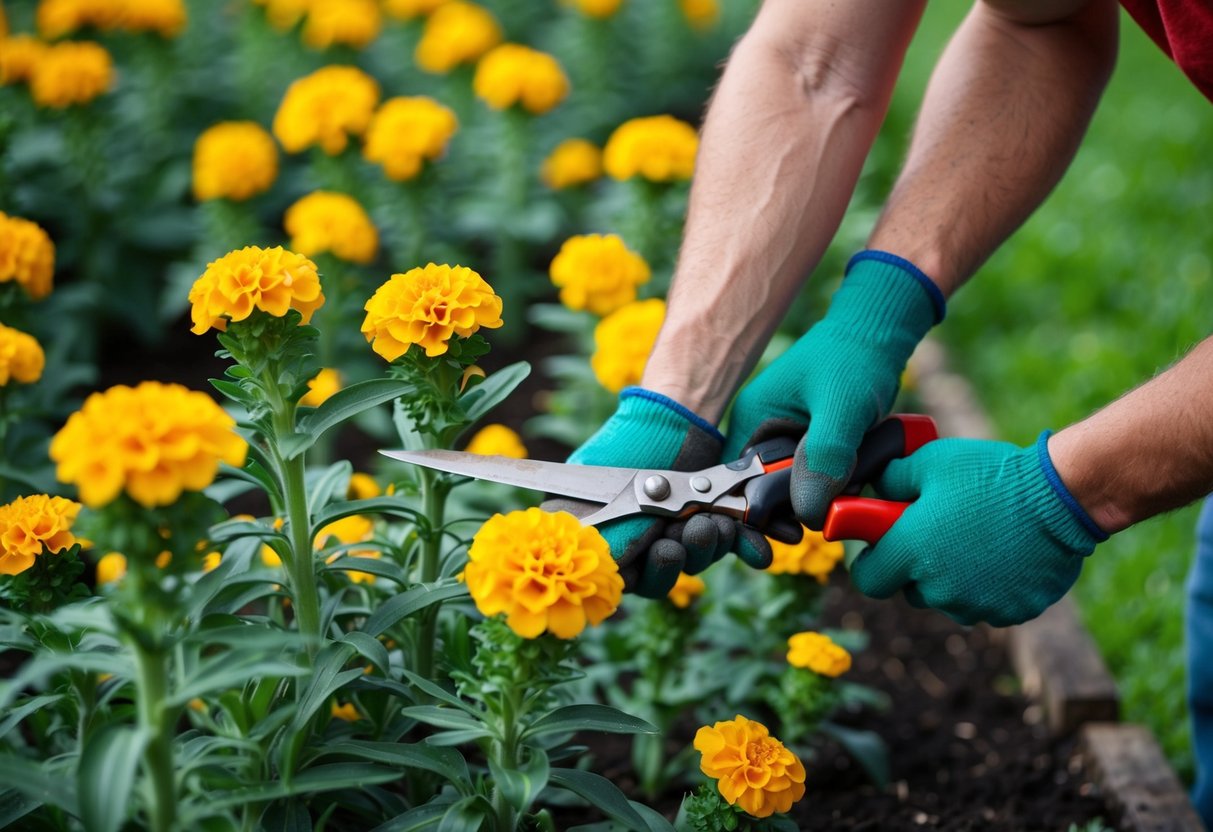
Keeping your marigolds healthy involves addressing challenges like leggy growth and improving air circulation. Both of these can affect how full and vibrant your plants become.
Dealing with Leggy Marigold Plants
Leggy plants often have long, thin stems with few leaves. This usually happens when they don’t get enough sunlight or when they’re too crowded.
To help solve this, pinch back the stems above a set of leaves. This encourages your marigolds to grow bushier and produce more flowers.
Spacing your plants correctly is crucial. Make sure there’s enough room for each marigold to get plenty of light and air. Consider planting marigolds at least 6-12 inches apart. This helps prevent them from growing tall and weak.
Improving Air Circulation
Good air circulation is essential for marigold health. Without it, plants can become prone to diseases and pests.
Pruning is a great way to improve air flow among your marigolds. Trim away any dead or crowded stems with garden scissors to open up the space around your plants.
Avoid planting marigolds too close together. Proper spacing lets air move freely among the plants, reducing the chance of fungal infections.
If your garden is crowded, consider thinning them out to create more space.
You can also use fans to boost circulation in a greenhouse setting to ensure vigorous growth.







